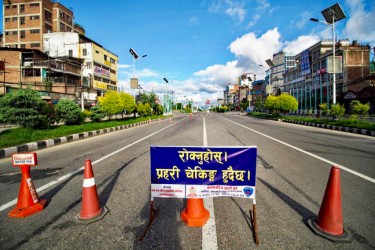Covid in Nepal: facts and consequences
Like all countries in the world, Nepal is experiencing a real crisis linked to the Covid-19 epidemic. The inhabitants, as well as the partners with whom we work on site, have been greatly affected by this situation and by the government measures taken to deal with it.
In a particularly difficult context, and in view of the information reaching us, it is complicated to estimate precisely the consequences, immediate or not, that this crisis will cause.
However, we have chosen, out of respect for our Nepalese partners, to take into account what we know. This situation is first and foremost a humanitarian crisis and we think it should be shared with you in complete transparency.
The situation of Nepal in the face of the coronavirus epidemic
Like many states, the Nepalese government first tried to control the spread of the virus by imposing strict lockdown of the population. Around March 20 2020, the artisans, including the seamstresses working for Bhangara, were forced to leave their workshops and return to their families in the provinces, far away from the capital.
The exit from this confinement, initially scheduled for June, has been postponed, from deadline to deadline, until September. This is due, in part, to the proximity of the neighboring country, India, whose figures continue to worry the authorities. In the first week of September, they still had 70,000 new infections every day.
In comparison, the Nepalese data leaves room for doubt, without the cause being clearly identified. Indeed, proven cases, such as deaths (56,788 in India and 371 en Nepal, as of 09/16/20), seem particularly low and inconsistent if we compare them with the global figures. It's hard to say if this is a flawed counting method, or if it´s the standard of living that already naturally limits the number of weak people, such as those with diabetes or the immunocompromised.

The impact of the epidemic on the lives of Nepalese
In any case, government measures undeniably have a direct impact on the daily lives of the people. The country, which until now has found an important resource in tourism, has been forced to close its borders.
Although commercial flights to Nepal have slightly resumed in recent days, the situation has been completely blocked for more than four months, causing a considerable lack of income for many Nepalese.
At the same time, the trekking season on Himalayan peaks such as Everest, Lhotse, Dhaulagiri, Annapurna I or Nanga Parbat, which usually attracts thousands of hikers, could not be held. Just to have an idea of the economic impact, a mountaineer pays for the ascent of Everest between $55,000 and $70,000, including $10,000 for climbing permits collected by the state. Knowing that in 2019, 644 people reached the summit via the Nepalese route, the loss for the administration as well as for the lodges, guides and sherpas, is astronomical.
The cancellation of this activity represents a major loss of revenue for the Nepalese government, which is struggling to keep its finances afloat.
As a direct consequence of this economic situation, the country is recording somber statistics. Recently, the suicide rate in Nepal has risen to unprecedented levels, confirming the daily difficulties of the Nepalese people.
But what will happen in the long term? The country is already one of the poorest countries in the world, with no social insurance or unemployment system for its inhabitants. With the absence of tourists, the interruption of international trade and the gradual migration from the countryside to the cities, Nepal seems to be in a very complex situation.
The effects on our activity
The health and safety of our partners in Nepal is a priority for Bhangara. It was obvious that we could not continue our production as the country faced this economic as well as humanitarian crisis. The fines for non-compliance with confinement were disproportionate compared to the salary of the Nepalese: it was therefore unthinkable to put our partners at risk of being arrested.
This is why we have taken on the responsibility of putting our production on hold during the four months of lockdown. Now we have been informed that the area in which our partners work is again under lockdown for another two weeks. However, they are still living close to the workshops.
The human being above all
As you know, Bhangara's aim is to offer responsible and ethical products. It is unthinkable to keep this focus in mind without taking care of our partners, who are going through a very difficult period. Our production will never be more important than the health and safety of our seamstresses.
Although our capacity to act on their behalf is somewhat limited, it is up to us to adapt our activity to this exceptional situation we all face. Out of solidarity and humanity, we must support all the Nepalese people. We hope to be in a position to help them as soon as possible to help them turn things around through our partnership, as well as your support, if you so wish.
Still, let's end on a positive note: we can now see the Himalayan range and the Everest from Kathmandu, which is very rare.

